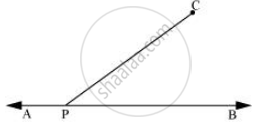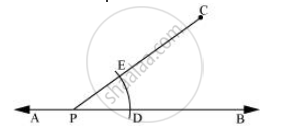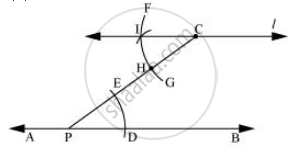Advertisements
Advertisements
प्रश्न
Draw a line, say AB, take a point C outside it. Through C, draw a line parallel to AB using ruler and compasses only
उत्तर
The steps of construction are as follows.
1) Draw a line AB. Take a point P on it. Take a point C outside this line. Join C to P.

2) Taking P as centre and with a convenient radius, draw an arc intersecting line AB at point D and PC at point E.

3) Taking C as centre and with the same radius as before, draw an arc FG intersecting PC at H.

4) Adjust the compasses up to the length of DE. Without changing the opening of compasses and taking H as the centre, draw an arc to intersect the previously drawn arc FG at point I.

5) Join the points C and I to draw a line 'l'.

This is the required line which is parallel to line AB.
APPEARS IN
संबंधित प्रश्न
Draw a line l. Draw a perpendicular to l at any point on l. On this perpendicular choose a point X, 4 cm away from l. Through X, draw a line m parallel to l.
Let l be a line and P be a point not on l. Through P, draw a line m parallel to l. Now join P to any point Q on l. Choose any other point R on m. Through R, draw a line parallel to PQ. Let this meet l at S. What shape do the two sets of parallel lines enclose?
Draw two parallel lines at a distance of 2.2 cm apart.
